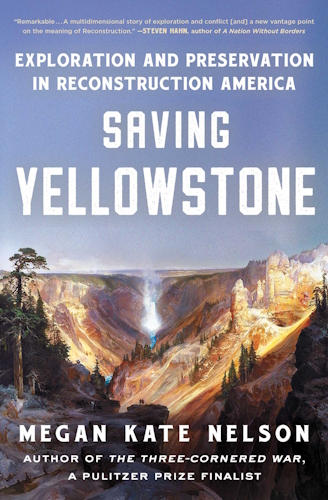Blog Books
Book: Saving Yellowstone
Yellowstone is a WHS that I haven’t visited yet – it requires a proper amount of time and I am even considering ‘saving’ it for my milestone 1,000th visited WHS. It has been inscribed on all 4 natural criteria, meets the 10 WHS Visitor Commandments and currently ranks #4 out of 1157 with an average visitor rating of 4.85 out of 5. Last year a new book was publicized about its history: Saving Yellowstone: Exploration and Preservation in Reconstruction America by Megan Kate Nelson.

What is it about
The book tells the story of how Yellowstone National Park came into being. Based on extensive archive research, it focuses on the period 1870-1872 and foremostly on the scientific expedition led by Ferdinand Hayden in 1871. His group was mostly fascinated by the geothermal nature of Yellowstone, with features that they did not fully understand how they originated. Their excited reports to the media fitted well within patriotic views too, as they underlined what was perceived as the singularity of the land the Americans inhabited.
The expansion of the railway system further west was a main driver for exploration, and many saw the commercial possibilities associated with increased tourism.
In the end, the legislation to declare the area a national park came through Congress quite smoothly. There was little opposition, but the native population wasn’t asked for its opinion of course. By establishing Yellowstone as a national park under the federal government, they wanted to avoid overcommercialism as was already the case at Niagara. It had turned out well a few years before in Yosemite. And it would be good for hunting too, as the animal populations would stay large in number!
Pros and cons of the book
There’s a great irony here as while she describes the 19th-century craving of the American audience for landscape paintings of Yellowstone with a Native American in it for decorative purposes, I found her style of writing also a bit of a pastiche of once popular adventure stories from the Wild West. I think I mentally disconnected at “Sitting Bull sat in front of his tent and lit a pipe”.
Also, I had hoped to find out more about the early years of conservation at Yellowstone, but the narrative ends already in 1872. Nelson clearly is more of a historian than a biologist.
The book gets good reviews overall, and you may like it if you’re into the distinctly American Popular History Writing genre.
Els - 10 September 2023
Comments
Jay T 10 September 2023
A classic park, and one of the inaugural class of World Heritage Sites; this will be a great site to mark for your 1000th. If at all possible when you do plan your visit, I would recommend traveling in September or October, when the summer vacation crowds have diminished and the weather is still generally nice.
Kyle Magnuson 10 September 2023
In History Academia in the U.S., the Reconstruction Era is currently the most trending Historical period to write about.